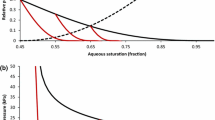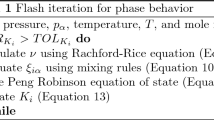Abstract
Predicting the fate of the injected CO2 is crucial for the safety of carbon storage operations in deep saline aquifers: especially the evolution of the position, the spreading and the quantity of the mobile CO2 plume during and after the injection has to be understood to prevent any loss of containment. Fluid flow modelling is challenging not only given the uncertainties on subsurface formation intrinsic properties (parameter uncertainty) but also on the modelling choices/assumptions for representing and numerically implementing the processes occurring when CO2 displaces the native brine (model uncertainty). Sensitivity analysis is needed to identify the group of factors which contributes the most to the uncertainties in the predictions. In this paper, we present an approach for assessing the importance of model and parameter uncertainties regarding post-injection trapping of mobile CO2. This approach includes the representation of input parameters, the choice of relevant simulation outputs, the assessment of the mobile plume evolution with a flow simulator and the importance ranking for input parameters. A variance-based sensitivity analysis is proposed, associated with the ACOSSO-like meta-modelling technique to tackle the issues linked with the computational burden posed by the use of long-running simulations and with the different types of uncertainties to be accounted for (model and parameter). The approach is tested on a potential site for CO2 storage in the Paris basin (France) representative of a project in preliminary stage of development. The approach provides physically sound outcomes despite the challenging context of the case study. In addition, these outcomes appear very helpful for prioritizing the future characterisation efforts and monitoring requirements, and for simplifying the modelling exercise.
Similar content being viewed by others
References
Bouc, O., Bellenfant, G., Dubois, D., Guyonnet, D., Rohmer, J., Gastine, M., Wertz, F., Fabri, H.: Geological Storage Safety Assessment: Methodological Developments. PSAM 10 - 10 th International Probabilistic 2 Assessment & Management Conference, Seattle, United States (2010)
Nghiem, L., Yang, C., Shrivastava, V., Kohse, B., Hassam, M., Card, C.: Risk mitigation trough the optimization of residual gas and solubility trapping for CO2 Storage in saline aquifers. Energy Procedia. 1, 3015–3022 (2009)
MacMinn, C.W., Szulczewski, M.L., Juanes, R.: CO2 migration in saline aquifers. Part 1. Capillary trapping under slope and groundwater flow. J. Fluid Mech. 662, 329–351 (2010)
Juanes, R., Spiteri, E.J., Orr, Jr., F.M., Blunt, M.J.: Impact of relative permeability hysteresis on geological CO2 storage. Water Resour. Res. 42, W12418 (2006). doi:10.1029/2005WR004806
Ennis-King, J., Paterson, L.: Role of convective mixing in the long-term storage of carbon dioxide in deep saline formations. Soc. Pet. Eng. J. 10(3), 349 356 (2005)
Gunter, W.D., Wiwchar, B., Perkins, E.H.: Aquifer disposal of CO2-rich greenhouse gases: Extension of the time scale of experiment for CO2-sequestering reactions by geochemical modeling. Miner. Pet. 59(1–2), 121–140 (1997)
Hesse, M.A., Tchelepi, H.A., Cantwell, B.J., Orr Jr, F.M.: Gravity currents in horizontal porous layers: transition from early to late self-similarity. J. Fluid Mech. 577, 363–383 (2007)
MacMinn, C.W., Szulczewski, M.L., Juanes, R.: CO2 migration in saline aquifers. Part 2. Capillary and solubility trapping. J. Fluid Mech. 688, 321–351 (2011)
Manceau, J.C., Rohmer, J.: Analytical solution incorporating history-dependent processes for quick assessment of capillary trapping during CO2 geological storage. Transport in Porous Media. 90, 721–740 (2011)
Doughty, C.: Modeling geologic storage of carbon dioxide: comparison of non-hysteretic and hysteretic characteristic curves. Energy Convers. Manag. 48(6), 1768–1781 (2007)
Doughty, C.: Investigation of CO2 Plume Behavior for a Large-Scale Pilot Test of Geologic Carbon Storage in a Saline Formation. Transp. Porous. Med. 82, 49–76 (2010)
Goater, A.L., Bijeljic, B., Blunt, M.J.: Dipping open aquifers—the effect of top-surface topography and heterogeneity on CO2 storage efficiency. Int. J. Greenhouse Gas Control. 17, 318–331 (2013)
Mathias, S.A., Gonzalez, G.J., Thatcher, K.E., Zimmerman, R.W.: Pressure buildup during CO2 injection into a closed brine aquifer. Transp. Porous Media 89(3), 383–397 (2011)
Ross, J.L., Ozbek, M.M., Pinder, G.F.: Aleatoric and epistemic uncertainty in groundwater flow and transport simulation. Water Resour. Res. 45, W00B15 (2009). doi:10.1029/2007WR006799
Class, H., Ebigbo, A., Helmig, R., Dahle, H.K., Nordbotten, J.M., Celia, M.A., et al.: A benchmark study on problems related to CO2, storage in geologic formations. Comput. Geosci. 13(4), 409–434 (2009)
Nordbotten, J.M., Flemisch, B., Gasda, S.E., Nilsen, H.M., Fan, Y., Pickup, G.E., et al.: Uncertainties in practical simulation of CO2 storage. Int. J. Greenhouse Gas Control 9, 234–242 (2012)
EC (European Comission): Directive 2009/31/EC of the European Parliament and of the Council of 23 April 2009 on the geological storage of carbon dioxide and amending Council Directive 85/337/EC, European Parliament and Council Directives 2000/60/EC, 2001/80/EC, 2004/35/EC, 2006/12/EC, 2008/1/EC and Regulation (EC) No 1013/2006 (2009)
Krevor, S., Pini, R., Zuo, L., Benson, S.: Relative permeability and trapping of CO2 and water in sandstone rocks at reservoir conditions. Water Resour. Res. 48, W02532 (2012)
Pini, R., Krevor, S., Benson, S.: Capillary pressure and heterogeneity for the CO2/water system in sandstone rocks at reservoir conditions. Adv. Water Resour. 38, 48–59 (2012)
Mathias, S.A., Gluyas, J.G., Gonzalez Martinez de Miguel, G.J., Bryant, S.L., Wilson, D.: On relative permeability data uncertainty and CO2 injectivity estimation for brine aquifers. Int. J. Greenhouse Gas Control. 12, 200–212 (2013)
Rohmer, J., Bouc, O.: A response surface methodology to address uncertainties in cap rock failure assessment for CO2 geological storage in deep aquifers. Int. J. Greenhouse Gas Control 4, 198–208 (2010)
Ashraf, M., Oladyshkin, S., Nowak, W.: Geological storage of CO2: application, feasibility and efficiency of global sensitivity analysis and risk assessment using the arbitrary polynomial chaos. Int. J. Greenhouse Gas Control 19, 704–719 (2013)
Storlie, C.B., Reich, B.J., Helton, J.C., Swiler, L.P., Sallaberry, C.J.: Analysis of computationally demanding models with continuous and categorical inputs. Reliab. Eng. Syst. Saf. 113, 30–41 (2013)
Saltelli, A., Ratto, M., Andres, T., Campolongo, F., Cariboni, J., Gatelli, D., Saisana, M., Tarantola, S.: Global Sensitivity Analysis—The Primer. Wiley, New York (2008)
Storlie, C.B., Bondell, H.D., Reich, B.J., Zhang, H.H.: Surface estimation, variable selection, and the nonparametric oracle property. Stat. Sin. 21, 679–705 (2010)
Manceau, J.C., Rohmer, J.: Ranking importance of uncertainties for the assessment of residual and dissolution trapping of CO2 on a large-scale storage site. Energy Procedia 63, 3658–3664 (2014)
Audigane, P., Gaus, I., Czernichowski, L.I., Pruess, K., Xu, T.: Two-dimensional reactive transport modeling of CO2 injection in a saline aquifer at the sleipner site. North Sea Am. J. Sci. 307(7), 974–1008 (2007)
Pruess, K., Oldenburg, C.M., Moridis, G.J.: TOUGH2 User’s Guide, Version 2.0. LBNL Report LBNL-43134 (1999)
Pruess, K., Spycher, N.: ECO2N—a fluid property module for the TOUGH2 code for studies of CO2 storage in saline aquifers. Energy Convers. Manag. 48(6), 1761–1767 (2007)
Doughty, C.: User’s Guide for Hysteretic Capillary Pressure and Relative Permeability Functions in ITOUGH2. In: Report LBNL-2483E. Lawrence Berkeley National Laboratory, Berkeley, CA, USA (2009)
Land, C.S.: Calculation of imbibition relative permeability for two and three-phase flow from rock properties. Soc. Pet Eng. J. 8(2), 149–156 (1968)
van Genuchten, M.T.: A closed-form equation for predicting the hydraulic conductivity of unsaturated soils. Soil Sci. Soc. Am. J. 44, 892–898 (1980)
Lenhard, R.J., Parker, J.C.: A model for hysteretic constitutive relations governing multiphase flow—2. Permeability–saturation relations. Water Resour. Res. 23(12), 2197–2205 (1987)
Sobol’, I. M.: Sensitivity estimates for non linear mathematical models. Math. Model. Comput. Exp. 1, 407–414 (1993)
Rohmer, J., Douglas, J., Bertil, D., Monfort, D., Sedan, O.: Weighing the importance of model uncertainty against parameter uncertainty in earthquake loss assessments. Soil Dyn. Earthq. Eng. 58, 1–9 (2014). doi:10.1016/j.soildyn.2013.11.006
McKay, M.D., Beckman, R.J., Conover, W.J.: A comparison of three methods for selecting values of input variables in the analysis of output from a computer code. Technometrics 21, 239–245 (1979)
Hastie, T., Tibshirani, R., Friedman, J.: The Elements of Statistical Learning: Data Mining, Inference, and Prediction, 2nd Edition. Springer, New York (2009)
Meyer, R.: Anisotropy of sandstone permeability. CREWES Res. Rep., 14 (2002)
Larkin, R.G.: Hydrodynamic trapping of CO2 geosequestrated in saline aquifers. SPE 128205. 2010 Improved Oil Recovery Symposium held in Tulsa, Oklahoma, USA (2010)
Akbarabadi, M., Piri, M.: Relative permeability hysteresis and capillary trapping characteristics of supercritical CO2/brine systems: an experimental study at reservoir conditions. Adv. Water Resour. 52, 190–206 (2013)
Bennion, D.B., Bachu, S.: Drainage and imbibition relative permeability relationships for supercritical CO2/brine and H2S/brine systems in intergranular sandstone, carbonate, shale, and anhydrite rocks. SPE Reservoir. Eval. Eng. 11(3), 487–496 (2008)
Perrin, J.-C., Benson, S.: An experimental study on the influence of sub-core scale heterogeneities on CO2 distribution in reservoir rocks. Transp. Porous. Media 82, 93–109 (2010)
Berg, S., Oedai, S., Ott, H.: Displacement and mass transfer between saturated and unsaturated CO2-brine systems in sandstone. Int. J. Greenhouse Gas Control 12, 478–492 (2013)
Pentland, C.H., El-Maghraby, R., Iglauer, S., Blunt, M.J.: Measurements of the capillary trapping of super-critical carbon dioxide in Berea sandstone. Geophys. Res. Lett. 38, L06401 (2011)
Alkan, H., Cinar, Y., Ülker, E. B.: Impact of capillary pressure, salinity and in situ conditions on CO2 injection into saline aquifers. Transp. Porous Media. 84, 99–819 (2010)
Audigane, P., Chiaberge, C., Mathurin, F., Lions, J., Picot-Colbeaux, G.: A workflow for handling heterogeneous 3D models with the TOUGH2 family of codes: applications to numerical modeling of CO2 geological storage. Comput. Geosci. 37, 610–662 (2011)
Saltelli, A.: Making best use of model evaluations to compute sensitivity indices. Comput. Phys. Commun. 145, 280– 97 (2002)
R. Development Core Team: R: A language and environment for statistical computing. R Foundation for Statistical Computing, Vienna, Austria. ISBN 3-900051-07-0, http://www.R-project.org/ (2012)
Sobol’, I.M., Tarantola, S., Gatelli, D., Kucherenko, S.S., Mauntz, W.: Estimating the approximation error when fixing unessential factors in global sensitivity analysis. Reliab. Eng. Syst. Safety. 92, 957–960 (2007). doi:10.1016/j.ress.2006.07.001
Rohmer, J.: Combining meta-modeling and categorical indicators for global sensitivity analysis of long-running flow simulators with spatially-dependent inputs, available online Computational geosciences. doi:10.1007/s10596-013-9391-x (2014)
Gu, C.: Smoothing Spline ANOVA Models. Springer, New York (2002)
Lin, Y., Zhang, H.: Component selection and smoothing in smoothing spline analysis of variance models. Ann. Stat. 34, 2272–2297 (2006)
Kohavi, R.: A study of cross-validation and bootstrap for accuracy estimation and model selection. In: Proceedings of the 14th International Joint Conference on Artificial Intelligence, Montreal, Canada, vol. 2, pp 1137–1143 (1995)
Craven, P., Wahba, G.: Smoothing noisy data with spline functions: estimating the correct degree of smoothing by the method of generalized cross-validation. Numer. Math. 31, 377–403 (1979)
Author information
Authors and Affiliations
Corresponding author
Rights and permissions
About this article
Cite this article
Manceau, J., Rohmer, J. Post-injection trapping of mobile CO 2 in deep aquifers: Assessing the importance of model and parameter uncertainties. Comput Geosci 20, 1251–1267 (2016). https://doi.org/10.1007/s10596-016-9588-x
Received:
Accepted:
Published:
Issue Date:
DOI: https://doi.org/10.1007/s10596-016-9588-x




